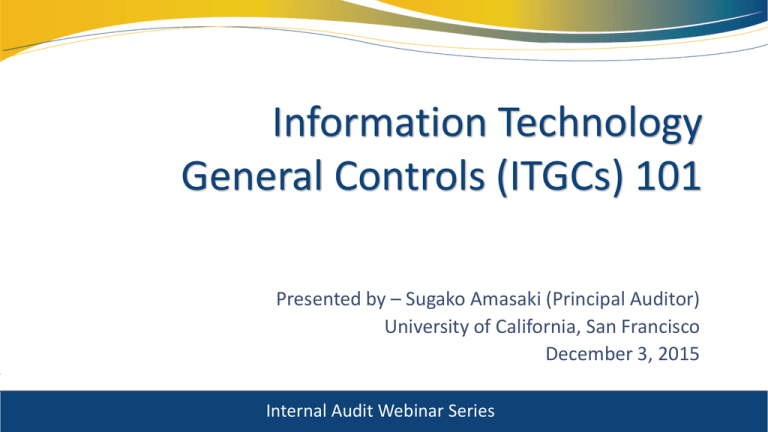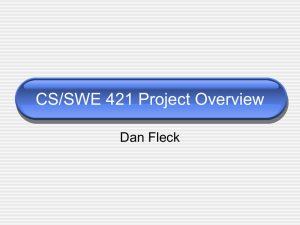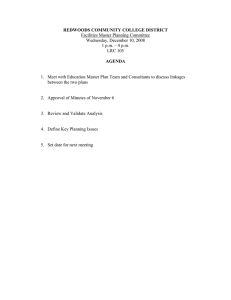IT General Controls (ITGCs) 101 Presentation
advertisement

Information Technology General Controls (ITGCs) 101 Presented by – Sugako Amasaki (Principal Auditor) University of California, San Francisco December 3, 2015 Internal Audit Webinar Series Webinar Agenda Introduction Why are IT General Controls Important? Types of Controls IT General Controls Review - Audit Process IT General Controls Review - Overview and Examples Access to Programs and Data Program Changes and Development Computer Operations Q&A Why are IT General Controls Important? IT systems support many of the University’s business processes, such as these below: Finance Purchasing Research Patient care Inventory Payroll We cannot rely on IT systems or data therein without effective IT General Controls Why are IT General Controls Important? Financial Objectives, such as: - Completeness - Accuracy - Validity - Authorization Operational & IT Objectives, such as: - Confidentiality - Integrity - Availability - Effectiveness and Efficiently Ineffective ITGCs = No achievement of business objectives Types of Controls How are controls implemented? Automated Controls Manual Controls Partially Automated Controls What are controls for? Preventive Controls Detective Controls Corrective Controls IT General Controls Review - Audit Process 1. Understand and identify the IT Environment and systems to be reviewed 2. Perform interviews, walkthroughs, and documentation reviews to gain an understanding on processes 3. Assess appropriateness of existing control environment (control design) 4. Validate existing controls to assess control operating effectiveness IT General Controls Review - Overview Access to Program and Data IT General Controls Access to Program and Data Program Changes Program Development Computer Operations Risk: Unauthorized access to program and data may result in improper changes to data or destruction of data. Objectives: Access to program and data is properly restricted to authorized individuals only. IT General Controls Review - Overview Access to Programs and Data Access to programs and data components to be considered: Policies and procedures User access provisioning and de-provisioning Periodic access reviews Password requirements Privileged user accounts Physical access Appropriateness of access/segregation of duties Encryption System authentication Audit logs Network security IT General Controls Review - Example Access to Programs and Data Area User access provisioning Existing Control Design How to Test/Validate A formal process for granting or modifying system access (based Review an evidence of approval on appropriate level of approval) is in place. User access A formal process for disabling access for users that are de-provisioning transferred or separated is in place. Compare existing user accounts with a list of users that are transferred or separated Periodic access reviews Periodic access reviews of users, administrators, and third-party Review an evidence of periodic vendors are performed. reviews Password requirements Unique (to individual) and strong passwords are used. Assess password rules enforced Privileged user accounts Accounts having privileged system access rights (e.g. servers, databases, applications, and infrastructure) are limited to authorized personnel. Review accounts with privileged access rights Physical access Only authorized personnel are allowed to access secured areas and computer facilities. Walkthrough of areas (e.g. data center, backup storage etc.) IT General Controls Review - Overview Program Changes and Development IT General Controls Access to Program and Data Program Changes Risk: Inappropriate changes to systems or programs may result in inaccurate data. Objectives: All changes to existing systems are properly authorized, tested, approved, implemented and documented. Program Development Computer Operations Risk: Inappropriate system or program development or implementation may result in inaccurate data. Objectives: New systems/applications being developed or implemented are properly authorized, tested, approved, implemented and documented. IT General Controls Review - Overview Program Changes and Development Program changes and development components to be considered: Change management procedures and system development methodology Authorization, development, implementation, testing, approval, and documentation Migration to the production environment (Separation of Duties (SOD)) Configuration changes Emergency changes Data migration and version controls Post change/implementation testing and reviews IT General Controls Review - Example Program Changes and Development Area Existing Control Design How to Test/Validate Change management controls A formal process for proper change management is in place. Review/assess change management procedures and validate that procedures are followed Change documentation All changed made to systems (e.g. servers, databases, applications, batch jobs and infrastructure) are documented and tracked. Review change logs Testing Appropriate level of testing is performed. Review an evidence of test plans and results Approval Appropriate approval prior to migration to production is required. Review an evidence of approval Migration Access to migrate changes into production is appropriately restricted. Verify that a separation of duties (SOD) between developers and operators (= making changes) exists IT General Controls Review - Overview Computer Operations IT General Controls Access to Program and Data Program Changes Program Development Computer Operations Risk: Systems or programs may not be available for users or may not be processing accurately. Objectives: Systems and programs are available and processing accurately. IT General Controls Review - Overview Computer Operations Computer operations components to be considered: Batch job processing Monitoring of jobs (success/failure) Backup and recovery procedures Incident handling and problem management Changes to the batch job schedules Environmental controls Disaster Recovery Plan (DRP) and Business Continuity Plan (DRP) Patch management IT General Controls Review - Example Computer Operations Area Existing Control Design How to Test/Validate Batch job processing Batch jobs are appropriately scheduled, processed, monitored, and tracked. Review/assess procedures for batch job processing and monitoring and validate that procedures are followed Monitoring of jobs Failed jobs are followed-up and documented (including successful resolutions and explanations) Validate that failed jobs are followed-up and documented Backup and recovery Backups for critical data and programs are available in the event of an emergency. Review/assess procedures for backup and recovery and validate that procedures are followed Problem/issue management A formal process for problem/issue handling is in place in order to ensure timely identification, escalation , resolution and documentation of problem. Review/assess procedures for problem/issue management and validate that procedures are followed Conclusion/Q&A


